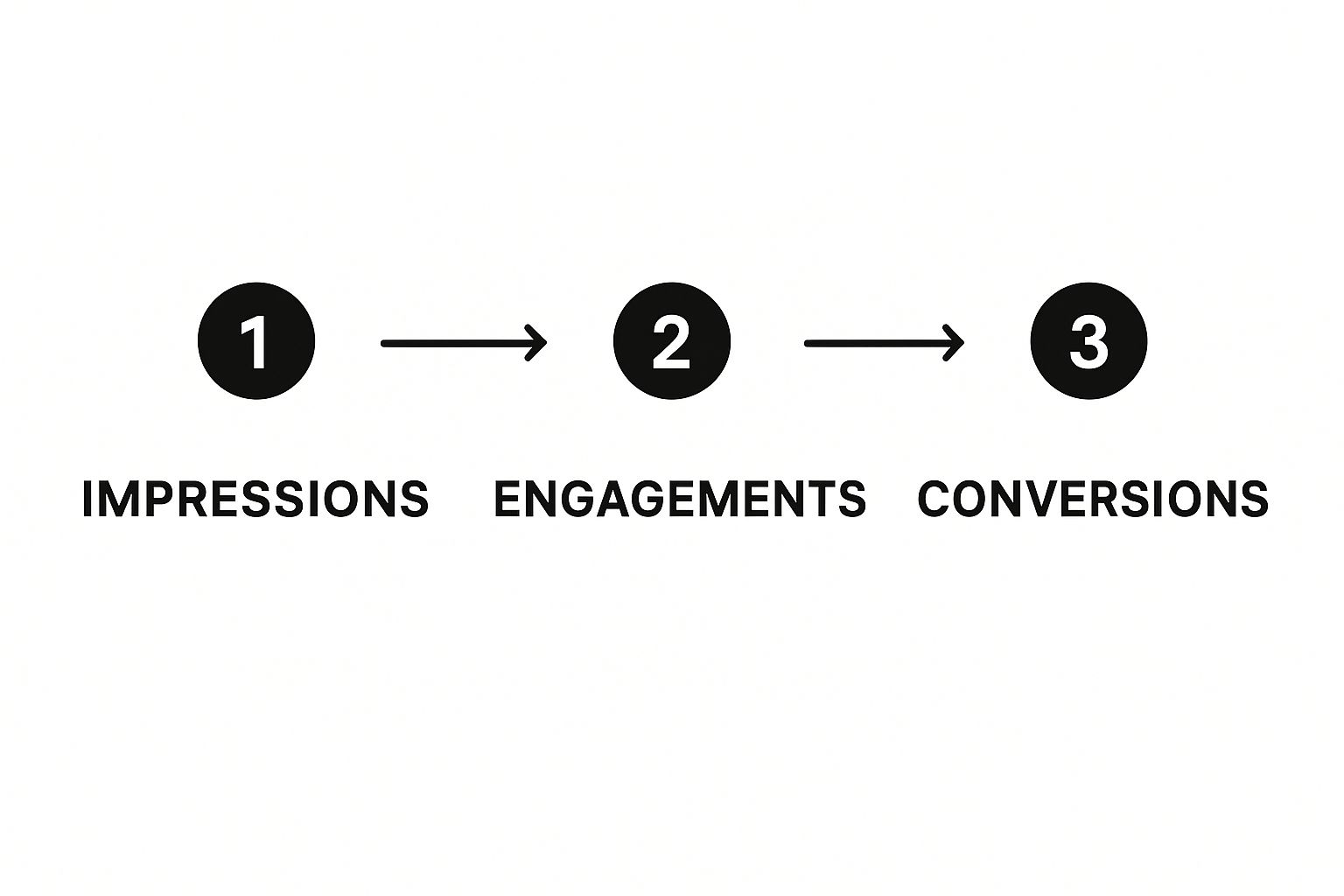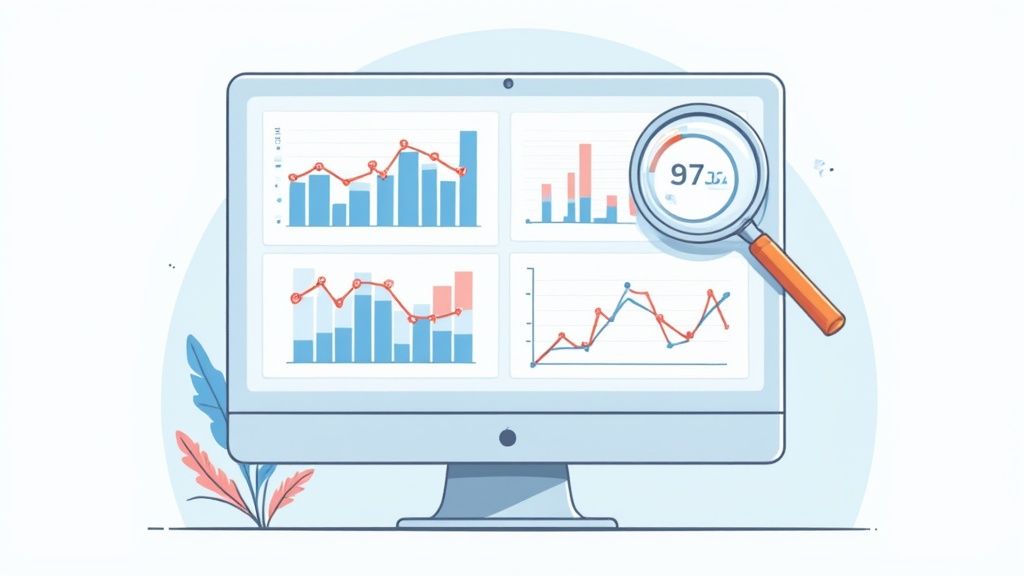
A Guide to Measuring Influencer Marketing ROI
Published
Measuring influencer marketing ROI is actually pretty straightforward once you have the right framework in place. At its core, it's about setting crystal-clear goals for your campaign, keeping a close eye on the right performance metrics, and knowing exactly what you’ve spent. From there, a simple formula can tell you the real financial return.
Why Measuring Influencer ROI Is No longer Optional
Let's be honest: the days of treating influencer marketing as a "spray and pray" tactic are long gone. The industry has matured. It’s moved from vague awareness goals to a data-driven channel where every dollar spent needs to be accounted for.
This isn't just about showing your boss a pretty report. It's about turning your influencer partnerships into a reliable, predictable growth engine for your business. To do that, you have to look past vanity metrics like likes and follows. You need a system that directly connects what an influencer does to a tangible business outcome, whether that's a sale, a lead, or a new subscriber.
The sheer scale of this channel makes measurement a necessity. By 2025, global spending on influencer marketing is projected to skyrocket to $32.55 billion. And it's not just a few big players; a recent analysis of over 2,500 campaigns found that 47% of marketers boosted their influencer budgets by 11% or more, all because they're chasing demonstrable returns. You can dive deeper into the data with this 2025 influencer marketing report.
Think of ROI as more than just a final report card. It's an ongoing feedback loop. The data you gather today informs every decision you make tomorrow—from which creators you work with to what kind of content actually moves the needle with your audience.
The Foundation of an ROI-Focused Campaign
Before you can even think about calculating ROI, you need to build your campaign on a solid foundation. This means having all the right pieces in place from the very beginning to ensure you can track performance from the first impression all the way to the final conversion.
To really get this right, you need to build a strategy that's designed for clear measurement from day one. If you want a deeper dive into optimizing your approach, you can explore these expert strategies to boost your influencer marketing ROI.
A strong foundation starts with a few core components working together. Each one plays a critical role in making sure your results are measurable and meaningful.
Here’s a quick look at the fundamental elements you'll need:
| Core Components of an ROI-Focused Influencer Campaign | | :--- | :--- | :--- | | Component | Description | Example Metric | | Clear Objectives | Defining the primary goal that guides the entire campaign. | Drive direct sales | | Targeted Metrics | Selecting KPIs that directly measure progress toward your main objective. | Conversion Rate | | Accurate Investment Tracking | Accounting for every single cost associated with the campaign. | Total Campaign Spend |
Getting these three elements right sets the stage for everything that follows. They are the non-negotiables for anyone serious about proving the value of their influencer marketing efforts.
The rest of this guide will walk you through exactly how to put these pieces into action.
Defining What Success Looks Like for Your Campaign

Before you can even begin to calculate your influencer marketing ROI, you have to get crystal clear on what a "return" actually means for your business. What counts as a home run for one brand might be a total swing-and-a-miss for another.
Vague goals like "boost brand awareness" just won't cut it. They’re fluffy, impossible to measure accurately, and don't give you anything solid to work with.
You need to anchor your campaign's success to a real, tangible business outcome. The whole point of setting clear objectives is to draw a straight line from what an influencer posts to a specific result that impacts your bottom line.
Think about it this way: a direct-to-consumer (D2C) apparel brand launching a new collection is chasing immediate sales. Their definition of success is purely transactional. On the other hand, a B2B SaaS company might work with influencers to generate qualified leads for a pricey software subscription, focusing their efforts at the top of the funnel. These are two completely different ballgames.
Aligning Goals with Key Performance Indicators
Once you've nailed down your core business goal, the next move is to pick the right Key Performance Indicators (KPIs) to track your progress. Think of your KPIs as the vital signs of your campaign—they tell you if things are healthy and moving in the right direction.
A classic mistake is getting caught up in vanity metrics that look good on paper but have zero connection to your actual objective. If your goal is to drive sales, obsessing over the number of 'Likes' on a post is a waste of energy.
Key Takeaway: Your goal should always dictate your KPIs, not the other way around. Don't let flashy, easy-to-track metrics distract you from what you're really trying to accomplish. Your KPIs should tell a story about business impact.
Let's break down how this looks in the real world with a few examples:
Goal: Drive Direct Sales (E-commerce Brand)
- Primary KPI: Conversion Rate from unique promo codes or affiliate links.
- Secondary KPIs: Average Order Value (AOV), Customer Acquisition Cost (CAC), and Return on Ad Spend (ROAS).
Goal: Achieve Brand Dominance (CPG Product Launch)
- Primary KPI: Share of Voice (SOV) in your market compared to key competitors.
- Secondary KPIs: Total Reach, Impressions, and the volume of Brand Mentions.
Goal: Generate High-Quality Leads (B2B Tech Company)
- Primary KPI: Number of Marketing Qualified Leads (MQLs) captured through a dedicated influencer landing page.
- Secondary KPIs: Cost Per Lead (CPL) and demo request submissions.
Getting this strategic alignment right is the foundation of any solid measurement plan. When you define success with this kind of precision, you stop hoping for a return and start engineering one. You’re not just guiding your campaign; you’re building a clear path for measuring influencer marketing ROI once the dust settles.
Choosing Metrics That Actually Drive Business Value

It’s incredibly easy to get lost in a sea of vanity metrics. We’ve all seen reports filled with impressive-looking numbers—likes, follower counts, even massive impression figures. But here’s the hard truth: those numbers often don't tell you a thing about your campaign's real impact. If you want to genuinely start measuring influencer marketing ROI, you have to stop chasing metrics that feel good and start focusing on ones that actually move the needle for your business.
The secret is aligning your metrics with what you’re trying to achieve. Not every campaign is designed for immediate sales, and that’s perfectly fine. A smart measurement strategy understands the entire marketing funnel, from sparking initial awareness all the way through to that final conversion.
This means you need to dig deeper than surface-level data. For instance, the industry is clearly shifting away from direct sales as the only measure of success. In fact, only about 30% of marketers are focused solely on immediate conversions. Metrics like engagement rate, reach, and brand lift are taking center stage because they build the foundation for long-term growth. It's also worth noting that brands partnering with influencers who have over 10,000 followers often see a 9.2% higher ROI, showing that creator size can really influence your results. You can dive into more of these industry trends in Shopify's detailed breakdown of influencer marketing statistics.
Awareness and Engagement Metrics That Matter
Think of awareness metrics as your top-of-funnel scorecard. They tell you how many eyeballs your content reached, which is absolutely vital for things like product launches or breaking into a new market.
- Reach: This is the big one—the total number of unique people who saw the influencer’s content. It’s your core measure of audience size.
- Impressions: This tells you the total number of times the content was displayed. If your impressions are much higher than your reach, it’s a great sign that people are seeing the content multiple times.
But engagement metrics are where the story gets really interesting. They prove that people didn't just passively see your content; they actually stopped and interacted with it. It’s the difference between someone glancing at your storefront and someone walking inside to browse.
A "Save" on an Instagram post is often a far more powerful indicator of purchase intent than a "Like." A save signals that the user found the content so valuable they want to revisit it later, which is a strong precursor to a future purchase.
Conversion and Brand-Centric Metrics
At the end of the day, most campaigns need to tie back to your bottom line. This is where conversion and brand-centric metrics become your best friends, connecting an influencer’s activity directly to business outcomes.
Conversion metrics give you the clearest picture of financial return:
- Clicks: The number of people who clicked a link in the influencer’s post, story, or bio.
- Leads: The number of potential customers you captured, usually tracked through a form on a dedicated landing page.
- Sales: The total revenue generated, which you can track precisely using unique discount codes or UTM-tagged affiliate links.
Beyond direct sales, don't sleep on brand-centric metrics. Brand lift is a powerful one that measures how much your campaign improved consumer perception and awareness. You can track this with simple post-campaign surveys that ask about brand recall or purchase intent. This gives you a much more complete view of value, proving that a great campaign drives both immediate revenue and lasting brand equity. If you want to get more granular on this, our guide on choosing the right influencer marketing KPIs offers a fantastic framework to get started.
How to Accurately Track Campaign Data and Attribution
Knowing what to measure is one thing, but actually getting the data is where the real work begins. If your tracking and attribution are shaky, you're basically just guessing about your campaign's impact. You can't connect the dots.
The whole point is to draw a clear, straight line from an influencer's post to a customer's action. This means going deeper than standard vanity metrics and using tools that properly credit the source. For any brand that's serious about growth, this isn't optional. To really dial in your influencer strategy, you need to rely on effective business analytics to gather and make sense of the information.
So, how do you get this level of precision? I've seen these methods work time and time again:
- Unique Promo Codes: This is the classic for a reason. It's simple, clean, and easy for everyone. Give each influencer their own code, like "CHLOE20", and you can instantly track every single sale they drive.
- UTM-Tagged Affiliate Links: Urchin Tracking Module (UTM) codes are small bits of text added to a URL. They tell your analytics platform exactly who sent the traffic, making them perfect for tracking clicks, traffic quality, and conversions from a specific influencer's content.
- Dedicated Landing Pages: For bigger campaigns or key influencer partners, I love creating a unique landing page. It completely isolates their traffic, so there's no question about where those sign-ups or sales came from.
Choosing the Right Attribution Model
Once you're pulling in data, you have to decide how you're going to give credit for each conversion. This is where attribution models come in. Think of them as the rulebook that decides which touchpoint gets the trophy for a sale. Your choice here can completely change how you perceive your ROI.
The two most common models you'll encounter are:
- Last-Click Attribution: This model gives 100% of the credit to the very last thing a customer clicked before buying. It’s straightforward to track, but it’s a bit shortsighted. It often ignores all the hard work an influencer did at the beginning of the customer's journey to build awareness.
- Multi-Touch Attribution: This is a much more sophisticated way to look at things. It spreads the credit across several touchpoints, recognizing that a customer might see an influencer's post, click a retargeting ad a week later, and then do a Google search before finally making a purchase.
My Two Cents: For influencer marketing, a multi-touch model almost always gives you a truer picture of an influencer’s value. It rightfully credits them for both introducing your brand and nurturing leads, not just for being the last click.
This flow chart gives a great visual of that winding path from a customer first hearing about you to actually buying something.

As you can see, a customer's journey is rarely a straight line. It's a series of interactions where an influencer can play a huge role. Picking the right tracking tools and attribution model ensures you can accurately measure content performance at every one of these crucial steps.
Calculating Your Influencer Marketing ROI with Confidence

This is where the rubber meets the road. At its heart, measuring influencer marketing ROI boils down to a pretty simple formula, but don't let that fool you. The accuracy of your final number depends entirely on how meticulously you track your total investment against your total return. Get this right, and you'll demystify the entire process.
The basic formula is: (Return - Investment) / Investment * 100% = ROI
While the math itself is straightforward, the real work lies in defining what counts as "Return" and "Investment." For a deep dive into mastering influencer marketing ROI and structuring campaigns that deliver real results, it helps to have a solid framework.
What Really Goes into Your Total Investment?
Your investment is so much more than just the check you write to the influencer. To get a true, honest ROI figure, you have to account for every single penny spent on the campaign. If you overlook these costs, you're just fooling yourself with an artificially inflated return.
Think about all the hidden expenses. Common costs you absolutely need to track include:
- Influencer Fees: The most obvious one—what you pay them directly for their work.
- Product Seeding: The retail or production cost of any products you send.
- Shipping and Handling: The cost to get those products into the influencer's hands.
- Software and Tools: Subscription fees for any influencer platforms, analytics software, or project management tools you use.
- Agency or Team Costs: The prorated salaries of your internal team or the fees for any agency managing the campaign.
- Content Production Costs: Any extra budget for professional videography, photography, or editing that isn't covered in the influencer's fee.
Adding all this up gives you the "Investment" piece of the puzzle. It’s the total cash you put out to bring the campaign to life.
How to Measure Your Total Return
Figuring out the "Return" side is where things get really interesting. For direct sales campaigns, it’s a cakewalk—just add up the revenue from their unique promo code or affiliate link.
But what about campaigns focused on lead generation or brand awareness? The trick is to assign a concrete monetary value to those outcomes.
Key Takeaway: To calculate the value of non-sales goals, look at your own historical data. If you know a lead from your blog converts to a customer 10% of the time, and your average customer lifetime value is $500, then every new lead from your influencer campaign is worth $50.
This simple exercise turns abstract metrics like "leads" into hard financial data, which is exactly what you need to prove the campaign's value. This focus on clear returns is why the industry is booming, with projections showing the global market hitting $32.55 billion by 2025. After all, 80% of marketers see influencer marketing as a powerful strategy for growth.
An E-commerce Campaign Example
To see how this works in practice, let's walk through a common e-commerce scenario. A clothing brand wants to drive direct sales with a fashion influencer.
This table breaks down a sample calculation, showing how to account for both the full investment and the resulting revenue.
Example ROI Calculation for an E-commerce Campaign
| Item | Cost / Value | Notes |
|---|---|---|
| INVESTMENT | ||
| Influencer Fee | $2,000 | The direct payment to the influencer for their posts. |
| Product & Shipping | $300 | Cost of goods and postage for the gifted items. |
| Team Time (Prorated) | $200 | Value of the marketing manager's time spent on the campaign. |
| TOTAL INVESTMENT | $2,500 | The complete cost of running the campaign. |
| RETURN | ||
| Direct Sales (Promo Code) | $9,000 | Total revenue generated from the influencer's unique code. |
| TOTAL RETURN | $9,000 | The total trackable income from the campaign. |
With these numbers, we can plug them into our formula:
- Calculation: ($9,000 - $2,500) / $2,500 * 100% = 260% ROI
This 260% ROI shows a clear and profitable return, proving the campaign was a success.
Using ROI Data to Optimize Future Campaigns
Measuring influencer marketing ROI isn't just about grading your last campaign. It's about building a smarter blueprint for your next one. This data is pure gold—it’s how you make more predictable decisions and turn your influencer program into a reliable engine for growth.
But let's be honest, insights are worthless if they just collect dust in a spreadsheet. The real work begins when you translate those numbers into tangible actions. You need to get granular and figure out what really moved the needle.
Finding Your Performance Pockets
Once you have all the campaign data, it's time to put on your detective hat. You're looking for patterns, those little pockets of high performance that show you what truly worked. This is how you shift from simply hoping for good results to actively engineering them.
Start by asking the right questions to uncover these hidden gems:
Which influencers delivered the goods? Forget follower counts for a moment. Instead, compare creators based on their cost-per-conversion or cost-per-lead. I've often found that an influencer with a smaller, highly-engaged audience can deliver far more value than a mega-influencer who costs a fortune but drives little action.
What content format came out on top? Did a quick, punchy 30-second TikTok video blow a beautifully crafted Instagram carousel out of the water? Knowing this helps you write creative briefs that are practically guaranteed to perform better next time.
Which message actually connected with people? Did you test different calls to action? Maybe a simple message about "free shipping" drove more sales than one focused on "premium quality." These seemingly small details are what refine your copy and supercharge your conversion rates.
By homing in on these high-leverage elements, you can double down on what works and confidently cut what doesn’t. It’s this cycle of learning and adapting that unlocks consistent returns and maximizes every dollar in your budget.
From Insights to Action
Armed with this knowledge, you can build a much more robust and predictable influencer program. This is bigger than just tweaking a single campaign; it's about fundamentally improving your entire approach. A great way to put this into practice is to master your influencer marketing strategy today by applying these learnings to every decision you make.
Your analysis should directly feed back into a few key areas:
Refined Influencer Selection: You can now prioritize future partnerships with creators who have a proven track record of driving results for your brand and your specific goals—not just those with impressive vanity metrics.
Smarter Negotiations: Walking into a negotiation with concrete data is a game-changer. When you can show an influencer their exact ROI from a past campaign, you're in a much stronger position to negotiate rates or even structure performance-based deals.
Better Creative Briefs: Imagine onboarding a new influencer and being able to give them a "greatest hits" reel of past top-performing content, messaging, and formats. You're setting them up for success from day one.
Common Questions About Measuring Influencer ROI
Even with the best plan in place, a few questions always seem to pop up once you get down to the business of measuring influencer marketing ROI. Let's tackle some of the most common hurdles and points of confusion I see marketers run into all the time.
How Do I Measure ROI for an Awareness Campaign?
This is a classic. When your main goal isn't direct sales, you have to get a bit creative and assign a monetary value to your awareness metrics. The go-to method for this is calculating Earned Media Value (EMV).
It’s actually pretty straightforward. You just take the total impressions your campaign pulled in and multiply that by the standard Cost Per Mille (CPM) for your industry. If you’re not sure what that is, a quick search for “[Your Industry] average CPM” will get you a reliable benchmark.
Think of EMV as what you would have spent on traditional paid ads to get the same number of eyeballs. Suddenly, a fuzzy metric like "reach" becomes a solid dollar amount you can plug right into your return calculation.
Beyond EMV, you should also be watching for other signs of brand lift. These are your secondary indicators that the campaign is truly working.
- Spikes in organic brand searches: Keep an eye on your Google Search Console. Did more people start searching for your brand name right after the campaign kicked off? That’s a great sign.
- More website traffic from social: Dig into your website analytics. Are you seeing a noticeable lift in referral traffic coming from the social platforms your influencers are on?
- Follower growth on your brand’s channels: A bump in your own follower count shows the campaign successfully guided interested people back to your home base.
What Is a Good ROI for Influencer Marketing?
Everyone wants to know the magic number, but the honest answer is: it depends. A "good" ROI is completely relative to your industry, profit margins, and what you were trying to achieve in the first place.
That said, we do have some solid benchmarks. Multiple studies consistently report an average return between $5 to $6.50 for every $1 spent. I've personally seen top-performing campaigns bring in $20 or more in return, so the potential is definitely there.
The most practical advice I can give is this: stop chasing a universal number and start benchmarking against your other marketing channels. If your influencer program is outperforming the ROI from your paid social or content marketing efforts, you know you’re on the right track.
How Soon Can I See a Return?
The timeline for seeing a return is directly linked to two things: your product's sales cycle and your campaign's main goal.
If you’re an e-commerce brand selling something like cosmetics or snacks, you could see a direct sales ROI within a few days—sometimes even hours—of an influencer's post going live. The path to purchase is short and sweet.
But for a B2B software company or a brand selling a car or a luxury vacation, the decision-making process is much longer. In those cases, it could take several months to see the financial return. You have to play the long game, tracking short-term wins like engagement and clicks while patiently waiting for the long-term outcomes like qualified leads and, eventually, the final sale. It’s all about seeing the complete picture.
Ready to take the next step in your career? At Influencer Marketing Jobs, we connect talented professionals with top opportunities in this dynamic field. Find your perfect role—from manager to director—on our dedicated job board. Start your search on influencermarketingjobs.net today!